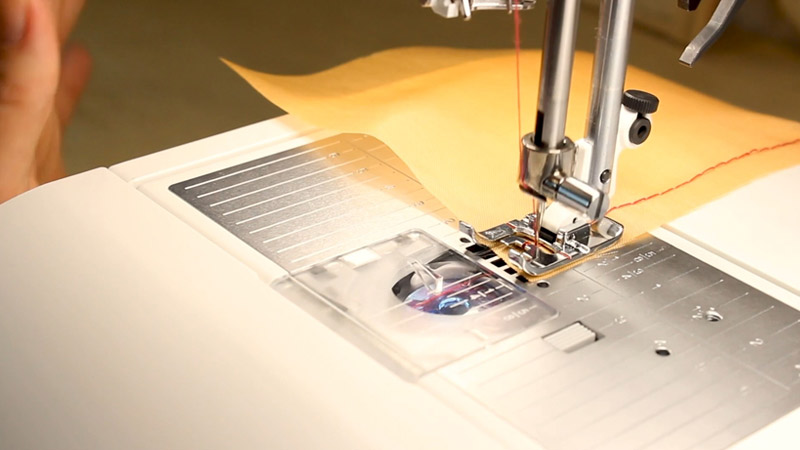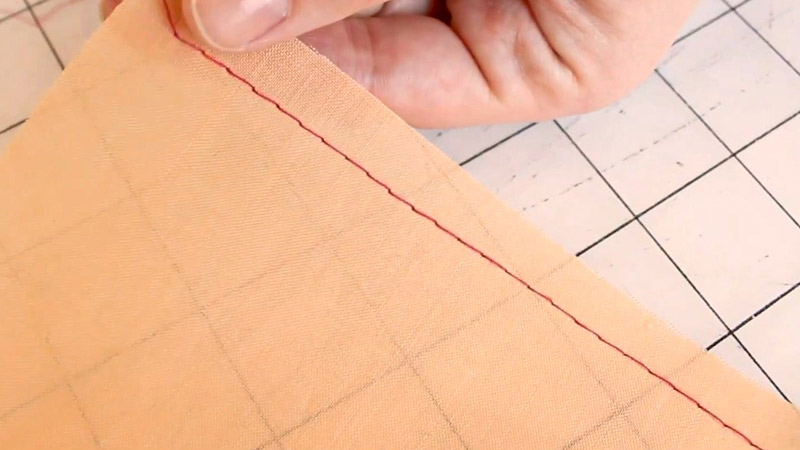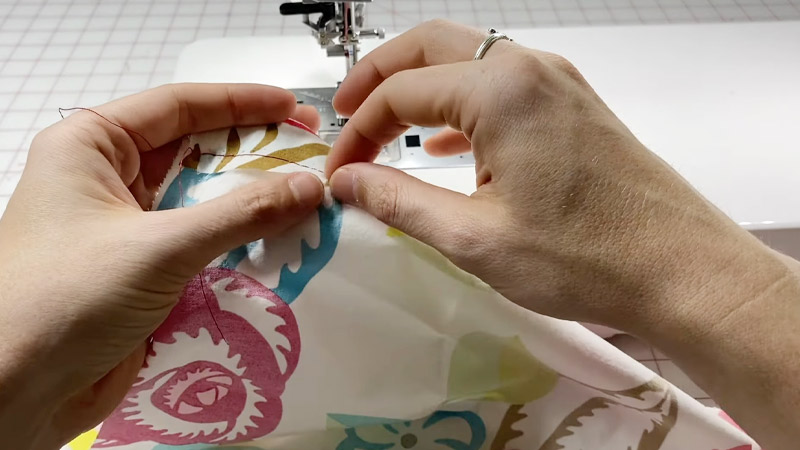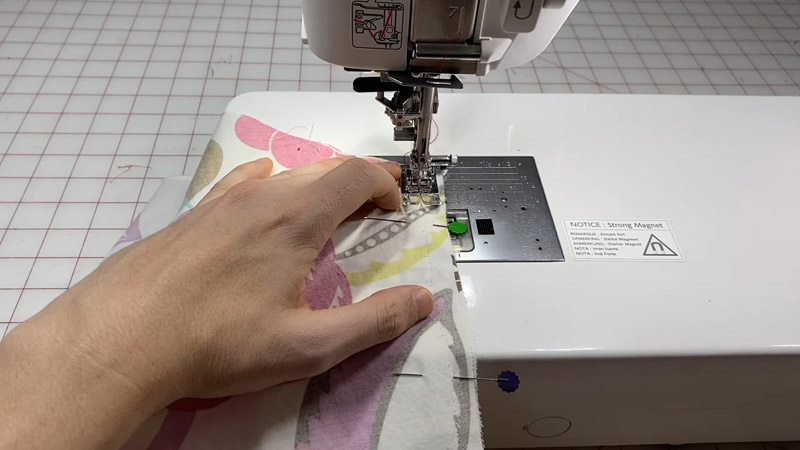In the realm of sewing, the term “baste” carries significant weight, representing a fundamental technique that forms the backbone of precision and quality in the craft.
Basting is the art of temporarily stitching fabric layers together, anchoring them in place before the final, permanent seams are sewn.
It’s a skill that seasoned sewers and novices alike must master, as it plays a pivotal role in achieving accurate alignments, ensuring the right fit, and preventing sewing mishaps.
Whether through hand or machine basting, this method serves as a guiding thread, facilitating intricate details, seamless patterns, and the flawless construction of garments, quilts, and various textile creations.

What Does Baste Mean in Sewing Terms?
In sewing terms, “baste” refers to a temporary stitching technique used to hold fabric layers together temporarily before the final sewing is done.
Basting is a crucial step in the sewing process, as it helps ensure that the fabric pieces align correctly and that the final stitches are neat and accurate.
This technique involves using long, loose stitches that can easily be removed once the permanent stitching is in place.
Here are some key points to understand about basting in sewing:
Temporary Stitching
Basting stitches are not intended to be permanent; they are simply a means to secure fabric layers in place temporarily.
They are meant to be removed after the final stitching is completed. Since basting stitches can be removed easily, they provide flexibility for adjustments during the sewing process.
Stitch Length
Basting stitches are typically longer than regular sewing stitches, making them easier to remove.
The stitch length may vary depending on the fabric and the purpose of the basting. A common basting stitch length is around 4-5 mm for machine basting.
Pin Alternative
Basting can be especially useful when working with delicate or slippery fabrics that may not hold pins securely.
Instead of using pins, which can damage or distort certain materials, basting stitches provide a gentler and more effective way to keep fabric layers together.
Alignment and Fit
Basting is essential for aligning pattern pieces accurately, such as when sewing garment seams or quilting blocks.
It allows you to check the fit and make any necessary adjustments before committing to permanent stitches.
Ease of Sewing
When sewing curved or intricate seams, basting helps distribute the fabric evenly and prevents puckering or bunching, resulting in a smoother and more professional finish.
Marking and Guidelines
Basting can also be used to mark sewing guidelines or lines for quilting patterns. These stitches serve as temporary reference points during the sewing process.
Ease of Removal
Basting stitches are intentionally loose, making them easy to remove without damaging the fabric.
You can simply pull the thread gently to take out the basting once the final stitching is complete.
What Is Baste Used For?

Basting has many uses in sewing, such as:
Working with Slippery or Delicate Fabrics
Basting is a lifesaver when you’re handling fabrics that tend to be slippery or delicate, such as silk, satin, velvet, or lace.
These fabrics can easily shift or stretch during sewing, leading to uneven seams or distorted shapes. Basting helps hold them in place securely, ensuring precise stitching and a polished finish.
Adding Details
When you’re attaching details like trims, zippers, buttons, or decorative elements to your sewing project, precision is crucial.
Basting allows you to position these elements exactly where you want them before sewing them permanently.
This ensures that they are aligned correctly and symmetrical, enhancing the overall appearance of your creation.
Creating Shapes and Textures
Basting is a versatile tool for shaping fabric to achieve various effects:
- Gathering: Basting can be used to create gathers, which are evenly-spaced folds in the fabric. This technique is commonly seen in ruffled sleeves or skirts.
- Pleating: Basting helps in forming precise pleats, which are folds in the fabric that create a tailored, structured look often seen in formalwear.
- Ruffling: Ruffles can be added to garments or home decor items like curtains, and basting ensures that the ruffles are evenly distributed and attached securely.
Testing Garment Fit
Before finalizing the seams of a garment, it’s essential to ensure that it fits well and has the desired shape.
Basting allows you to temporarily assemble the garment, enabling you to try it on for fit and comfort. If adjustments are needed, you can easily undo the basting and make changes without damaging the fabric.
Quilting and Appliqué
In quilting, basting plays a pivotal role in securing the layers of fabric and batting together.
Basting stitches can be long and loose, holding the layers in place before quilting, and preventing shifting and puckering during the quilting process.
Similarly, in appliqué work, basting holds fabric pieces in position temporarily until they are permanently stitched in place, ensuring precise placement.
How to Baste in Sewing?

Basting is a fundamental sewing technique that involves temporarily stitching fabric layers together to hold them in place until permanent sewing is done.
The method you choose for basting largely depends on your project, the type of fabric you’re working with, and personal preference.
Here are common methods for basting in sewing:
Hand Basting
- Materials: Needle, thread (preferably a contrasting color to make removal easier), and scissors.
- Technique: Use a running stitch, backstitch, or slip stitch to create long and loose stitches along the seam line or fabric edges. Ensure the stitches are evenly spaced and secure but not tight.
Machine Basting
- Materials: Sewing machine with straight or zigzag stitch capabilities, thread, and fabric.
- Technique: Set your sewing machine to the longest stitch length (usually 4-5 mm) and reduce the tension. Sew along the desired seam or fabric edge with long, loose stitches. Backstitch at the beginning and end to secure the basting.
Spray Basting
- Materials: Spray adhesive designed for fabrics and your fabric pieces.
- Technique: Lay one or both fabric pieces flat and apply a thin, even layer of the fabric-safe spray adhesive. Press the fabric pieces together, ensuring they align correctly.
Glue Basting
- Materials: Glue stick or liquid fabric glue suitable for your project and fabric.
- Technique: Apply the glue sparingly to one or both fabric surfaces where you want to baste. Press the glued areas together, ensuring alignment.
Tape Basting
- Materials: Fusible tape with adhesive on both sides and an iron.
- Technique: Cut the fusible tape to the desired length and place it between the fabric layers. Use an iron to apply heat, which fuses the layers together temporarily.
How Do You Remove Basting Stitches?
Removing basting stitches is a straightforward process, and it’s essential to do it carefully to avoid damaging the fabric.
Here’s how to remove basting stitches:
For Hand Basting

Locate the end of the basting thread. You can usually find this by inspecting the backside of the fabric or where the thread tail was left.
Gently grasp the end of the thread with your fingers or use a pair of tweezers to hold it.
Begin pulling the thread out in the direction opposite to how it was stitched. Pull steadily and slowly to prevent any snags or tears in the fabric.
Continue pulling until the entire length of the basting thread is removed.
For Machine Basting
Use a seam ripper or small scissors with a pointed tip to carefully cut one or two stitches near the beginning of the machine basting.
- Once you’ve cut a few stitches, you should be able to grasp the loose thread end.
- Gently pull on the thread, and the machine-basting stitches should start coming out.
- Continue pulling and removing the stitches one by one until all of them are removed.
For Basting with Adhesive (Spray Basting, Glue Basting, Tape Basting)
If you used spray basting, refer to the manufacturer’s instructions for any specific removal guidelines. In many cases, washing the project may dissolve the water-soluble adhesive.
For glue basting, if the glue is water-soluble, you can also wash the project to remove it. Be sure to check the fabric care instructions before washing.
For tape basting, simply peel the fusible tape away from the fabric. If any residue remains, use an iron with a pressing cloth to melt and remove the adhesive residue.
Be cautious not to damage the fabric while doing this.
Tips for Basting in Sewing

Basting is a crucial technique in sewing that can significantly improve the accuracy and quality of your projects.
Here are some tips to help you baste effectively:
Choose the Right Basting Method
Consider the nature of your project and the type of fabric you’re working with to determine whether hand basting, machine basting, or another method is most suitable.
Hand basting is precise but time-consuming, while machine basting is faster but may not be as precise for delicate fabrics.
Use Contrasting Thread for Hand Basting
When hand basting, it’s helpful to use a thread color that contrasts with your fabric.
This makes it easier to see the basting stitches and distinguish them from your final stitches.
When it’s time to remove the basting, you’ll quickly identify the contrasting thread and avoid damaging the fabric.
Proper Stitch Length for Machine Basting
When machine basting, set your stitch length to the longest available (usually 4-5 mm). Longer stitches are easier to remove and less likely to leave marks or perforate the fabric.
This setting ensures that the machine basting serves its temporary purpose without causing unnecessary damage or distortion to the fabric.
Test on Scrap Fabric Before Basting
Before basting on your actual project, it’s advisable to practice on a piece of scrap fabric.
This serves several purposes: it helps you get a feel for the basting technique, allows you to check your machine settings, and ensures you’re comfortable with the process.
It’s better to make any necessary adjustments on scrap fabric rather than your project.
Basting for Fit Checks
Basting is particularly valuable when sewing garments. It allows you to test the fit of the garment before committing to permanent seams.
When you baste garment pieces together temporarily, you can try them on, assess the fit, and make adjustments as needed.
This step can save you time and frustration by ensuring that your final seams result in a well-fitting garment.
Remove Basting as You Go
It’s a good practice to remove basting stitches as you progress through your sewing project.
As you complete permanent seams, take a moment to remove the basting in that area.
This keeps your work area tidy and prevents accidental sewing over basting stitches, which can be time-consuming to remove later and may affect the final appearance of your project.
Clean Up After Removing Basting Stitches
After you’ve successfully removed the basting stitches, it’s important to inspect the fabric for any remaining bits of thread or adhesive residue.
These remnants can be unsightly and affect the overall quality of your sewing project.
Use a lint roller, a pair of tweezers, or a small brush to clean up any stray thread bits or residue, leaving your fabric in pristine condition for further sewing or finishing touches.
FAQs
What does “baste” mean in sewing terms?
Basting in sewing refers to the temporary stitching of fabric layers together using long, loose stitches.
Why is basting important in sewing?
Basting ensures fabric alignment, pattern matching, and fit accuracy. It helps prevent errors and distortion, especially when working with delicate or slippery fabrics.
How do I remove basting stitches?
To remove basting stitches, gently pull the thread out in the opposite direction of the stitching.
What are common methods for basting in sewing?
Hand basting and machine basting are the most common methods. Hand basting uses a needle and thread, while machine basting is done with a sewing machine set to long stitches.
Can basting be used in quilting and other sewing projects?
Yes, basting is widely used in quilting to secure layers before quilting stitches are applied.
To Wrap Up
The concept of “baste” in sewing is an indispensable thread that weaves through the fabric of craftsmanship, guiding us toward precision and perfection.
It embodies the meticulous art of temporarily securing fabric layers, allowing us to test fits, align patterns, and ensure flawless seams before permanent stitching.
Whether through patient hand basting or efficient machine basting, this technique safeguards against missteps, ensuring our creations bear the mark of expertise.
In the rich tapestry of sewing, basting serves as both a foundation and a safeguard, empowering sewers to elevate their skills, achieve impeccable results, and bring their creative visions to life with confidence and competence.
Leave a Reply